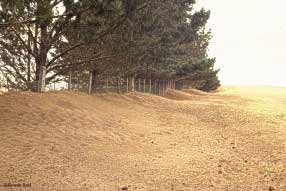|
Wind Erosion

Wind erosion occurs when the force of the wind is sufficient
to detach and carry soil particles. Windblown sands can damage
crops or bury young plants, then blow up against fences, buildings
and across roads, causing damage to infrastructure. The finer
surface soil particles and organic matter that hold the bulk
of the farm’s fertility can be blown for hundreds of
kilometres, causing major dust storms.
The Universal Soil Loss Equation (USLE) for wind erosion demonstrates
that changes in soil loss (as a function of soil erodability),
wind speed, paddock roughness, paddock length and vegetation
cover will influence the risk and extent of wind erosion.
The drier the soil and the higher the concentration of fine
sand, the greater its susceptibility to wind erosion. Heavy
clay soils may also be affected during very dry conditions
if the structure has been damaged by stock, traffic or excessive
cultivation. The presence of any vegetation, even dry grass,
reduces the risk of wind erosion. However, damage may still
occur during severe droughts, when pastures of crops fail
or when the lack of follow-up rains leave ploughed paddocks
or young crops exposed.
The ability of wind to dislodge and carry soil particles increases
exponentially with wind speed. This means that halving the
wind speed across an open paddock may be enough to eliminate
wind erosion in many circumstances. Research on shelterbelt
design shows that tall shelterbelts may be effective in halving
wind speeds over a distance equal to about ten times their
height.
Farmers are also able to reduce the extent of wind erosion
by reducing the length of the paddock. Wind-blown sands bouncing
along the surface induce a chain reaction causing more sand
to break free, a process called saltation. Leaving a strip
of ungrazed grass or a belt of trees between open paddocks,
thereby reducing the wind run, can dramatically reduce the
effect of saltation. Tree belts, if fenced to allow a thick
understorey to develop, can be effective in catching the moving
sands. The most appropriate paddock length will depend on
the soil type and the likely wind strengths. By observing
how soil erosion increases across their open paddocks, farmers
may be able to judge the maximum width of their ploughed areas.
Belts of trees can therefore reduce wind erosion by reducing
the wind speed and/or by reducing the length of the paddock.
In cropping areas the design criteria for an effective erosion
control shelterbelt might include:
• Tall trees to provide shelter over a long distance
• Aligning the belt perpendicular to the strong hot dry
winds that cause erosion
• Having good foliage cover to ground level to reduce
risk of wind tunnelling
• Fencing to prevent stock browsing and allowing grass
and shrubs to bind the soil beneath the trees
• Locating gateways in sheltered corners to avoid wind
tunnelling.
Trees
for Wind Shelter
Back to top
|
